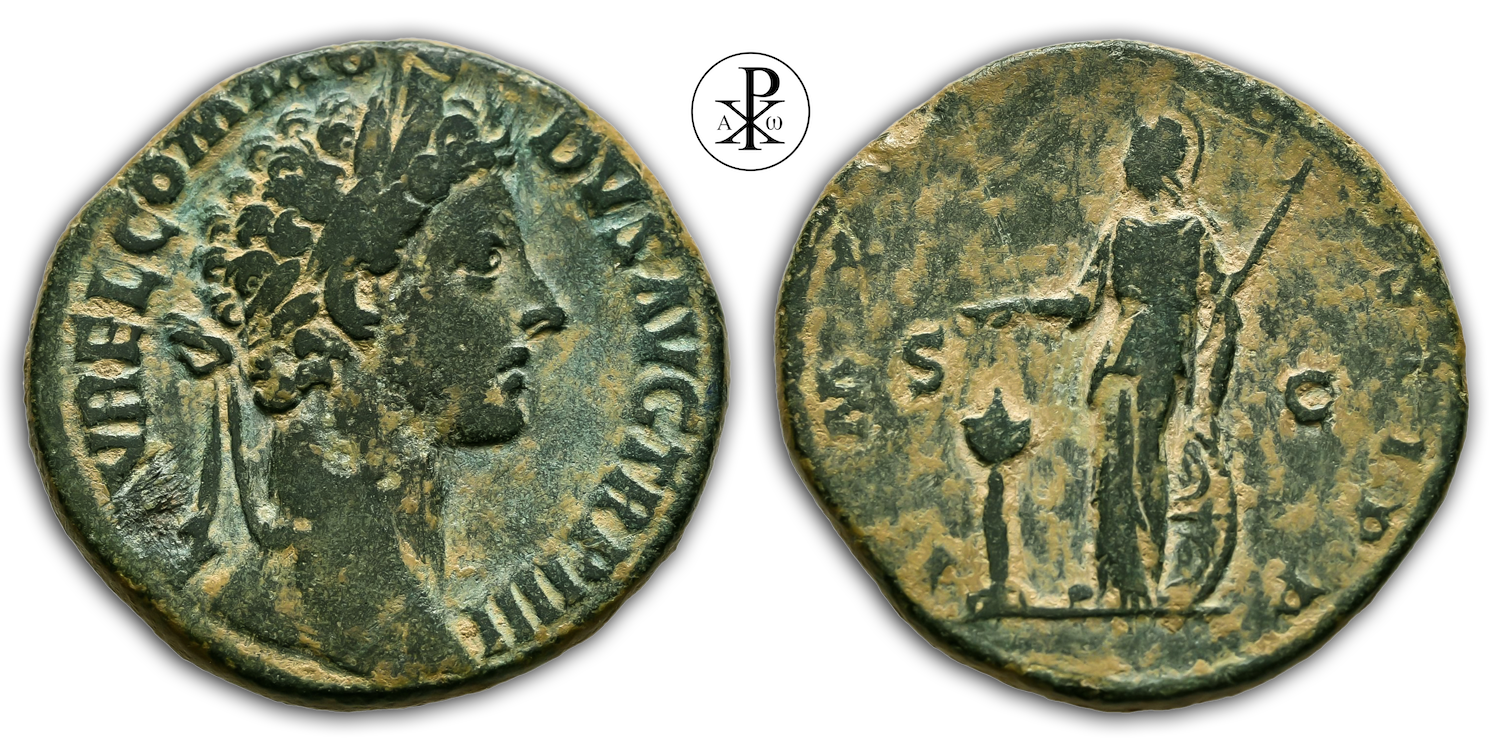Imperator Caesar Lucius Aelius Aurelius Commodus Augustus
Reign: Marcus Aurelius
Mint: Rome
Date: 179 AD
Nominal: Sestertius
Material: AE Bronze
Diameter: 31mm
Weight: 19.93g
Reference: RIC III Marcus Aurelius 1599
OCRE Online: http://numismatics.org/ocre/id/ric.3.m_aur.1599
Rare: R1
Provenance: Subastas Ibercoin Numismaticas Madrid, Spain (Auction 80, Lot 612)
Pedigree: –
Obverse: Head of Commodus, laureate, right
Inscription: L AVREL COMMODVS AVG TR P IIII
Translation: Lucius Aurelius Commodus, Augustus, Tribunicia Potestate Quarta
Translation: Lucius Aurelius Commodus, Augustus, holder of tribunician power for the fourth time
Reverse: Minerva, helmeted, draped, standing left, droping incense from right hand onto altar and resting left hand on round shield set on ground; spear rests against her left arm
Inscription: IMP II COS II P P S C
Translation: Imperator Secundum, Consul Secundum, Pater Patriae, Senatus Consultum
Translation: Imperator for the second time, consul for the second time, father of the nation. Decree of the senate
Comment: Minerva is a Roman goddess who was worshipped especially by the Sabines, Etruscans and Latins. The Etruscans called her Menrva. The Greek goddess Athena corresponds to her. In the Roman Empire, Minerva was initially regarded primarily as the protector of craftsmen and trades. Later, elements of the Greek cult of Athena were adopted into the image of Minerva, thus she also became the patron goddess of poets and teachers. Minerva was the goddess of wisdom, tactical warfare, art and shipbuilding, and guardian of knowledge. Since Augustus, she has been worshipped as the goddess bestowing victory or directing the fortunes of the state. A particular devotee of Minerva was the emperor Domitian, who often had her depicted on the reverse of his coins. In Rome, Minerva was worshipped as one of the three city deities on the Capitol, along with Jupiter and Juno. Her temple once stood in the center of the Aventine Hill. Today, however, no remains of it have survived. A second temple was located – also since Republican times – on the Esquiline. This was dedicated to Minerva Medica, who was the patron goddess of physicians. A third temple was located on the Caelius. This was named “Temple of Minerva Capta” because the cult image had been stolen by the Romans from the conquered Falerii in 241 BC.
The Sestertius of Commodus under Marcus Aurelius presented here can be narrowed down quite well in time in the edition. On 01 January 179 AD Commodus took up the second consulate together with Martius Verus. This marks the possible beginning of the editions. Commodus assumed the fifth “Tribunicia Potestate” on 10 December 179 AD. In addition, the third proclamation as Emperor took place around autumn 179 AD, after the outstanding victory of the Guard Prefect “Tarruntenus Paternus” in the decisive battle against the Teutons. In the winter of the same year, an army was encamped deep in the Quadenland near Laugaricio. The commander of these vexillations had an inscription “on the victory of the Augusti” set there in the castle rock of Trenèín on the river Waag, so that the victory of Paternus must have happened before. The minting time of this sestertius must therefore be between the beginning and autumn of AD 179, before the victory mentioned. The historical background is obvious – on 3 August of the year 178 AD, Marcus Aurelius and Commodus set out for the second Marcomannic war (“expeditio Germanica secunda”). The fighting dragged on for months, was fiercely contested and the final decisive battle weighed back and forth for a whole day. Minerva – also goddess of tactical warfare – was more in demand than ever.
